Adventure
Photographs and text by
Paul McDougall
Kenya has many beautiful natural wonders. It is teeming with wildlife. It has many National Parks and Reserves including Lake Nakuru National Park, Amboseli National Reserve, Tsavo National Park, Samburu National Reserve and the most famous Masai Mara National
Reserve.
All of the big 5 are found in Kenya. The big 5 are so named because they were considered the most challenging animals to hunt in colonial times and also the heads of these animals made the most impressive and sought after trophies. The big 5 are Lions, Leopard,
Elephant, Rhino and Buffalo.
The Giraffe is the tallest of African mammals. The male can grow up to 5.5 metres tall and the female up to 4.5 metres tall. In Kenya there are 3 different species of Giraffe. The Masai Giraffe founf in Masai Mara, The edangered Rothschilds Giraffe found in
Lake Nakuru and the Reticulated Giraffe found in Samburu, all species have different markings and distinct patterns to their coats.
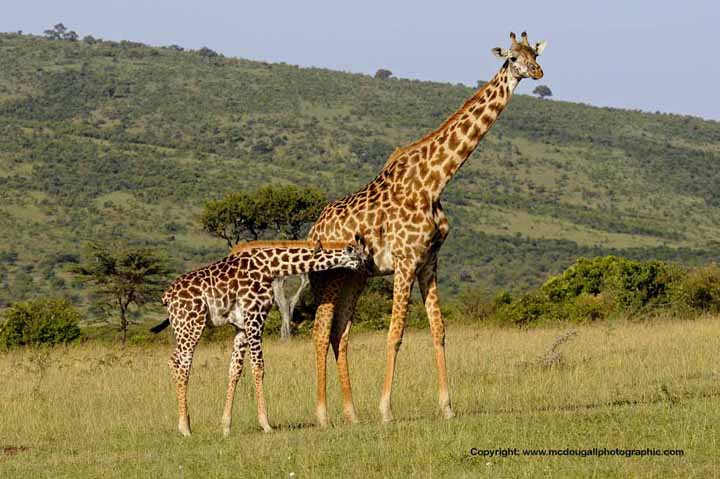
Masai Giraffe calf suckling
I have seen and photographed all 3 sub species of giraffe in Kenya, but the Masai Giraffe is probably my favorite. Giraffe can be very difficult to photograph, they often don’t do much and trying to get an interesting shot can be hard. One day we were driving
to Masai Mara, and not even in the reserve we came across a group of over 50 Giraffe, but it was the way that some were behaving that was so bizarre. We watched as some of the group stood in a line and proceeded to mount each other, it was the strangest of
sites seeing a line of giraffes doing this. I managed to get photographs of them doing this several times and 2 males necking and sparring with each other. I can honestly say that we spent an hour watching these giraffe, which is the longest I have ever spent.
This encounter just sums up how amazing our natural world is, and how unpredictable it can be. It just proves that if you think an animal is not that interesting to photograph, you always need to be prepared for something to challenge that pre-conception.
Growing tall gave the giraffe access to a 2m band of foliage beyond reach of any other large herbivore apart from the elephant, it is aided by its 45cm tongue. Browsing by giraffes can have big effects on their food trees, pruning of young trees keeps them
short for years longer than usual and makes waste bands around taller trees whose tops are beyond reach. Various species of the thorny acacia form the majority of their diet. The giraffe is protected when feeding on the sharp thorny trees by having a narrow
muzzle, extremely flexible upper lip and long prehensile tongue, these features enable it to strip leaves off branches or select individual leaves and shoots from in between thorns, therefore it can feed selectively and consume the 34 kg of vegetation per
day that it needs to sustain its bulk. Giraffes may drink at intervals of 3 days or less when water is available, but also get a lot of the moisture that they need through eating green leaves. Giraffes are gregarious and non territorial – they can form large
groups of over 50, however the groupings tend to be temporary and casual.
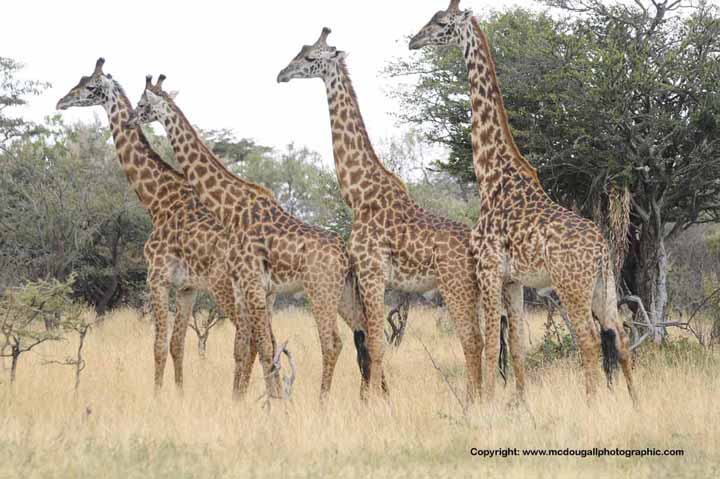
Masai Giraffe herd
A Giraffe has a very unusual walk – when walking it puts all the weight on the left side with both legs moving together and then all of the weight on the right with the right legs moving together. At a gallop the forefeet and the hindfeet work together in pairs,
even when travelling at 50-60kph the giraffe is so long legged that it looks like it is moving in slow motion.
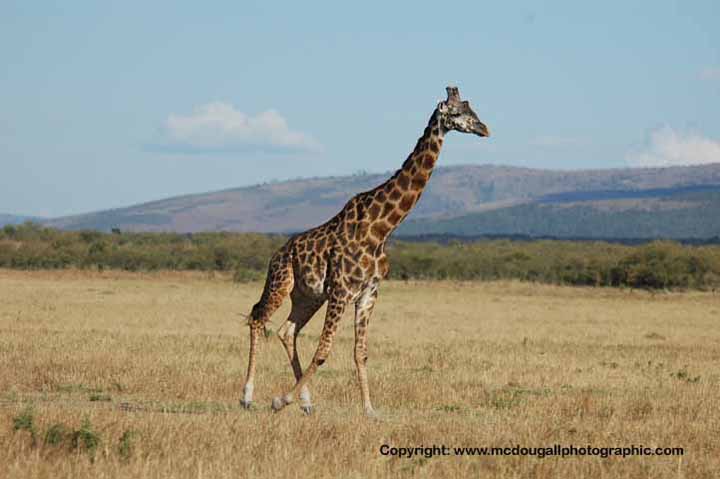
Masai Giraffe running
Giraffes have a long gestation period of 14 – 14.5 months, most conceptions occur during the rains when vegetation is at its most plentiful. Giraffes due to their great size, superior vision, speed and formidable hooves make them largely invulnerable to predators,
although lions if able to get a throat or nose hold are able to bring them down. Small calves however are very vulnerable to lions and hyenahs. As detailed above the three species of giraffes in Kenya can be seen in the parks detailed, The Rothschilds giraffe
can also be seen at the Giraffe Sanctuary in Nairobi, which has been set up to conserve these endangered animals, here it is possible to feed and stroke these beautiful animals whilst contributing towards conserving them.
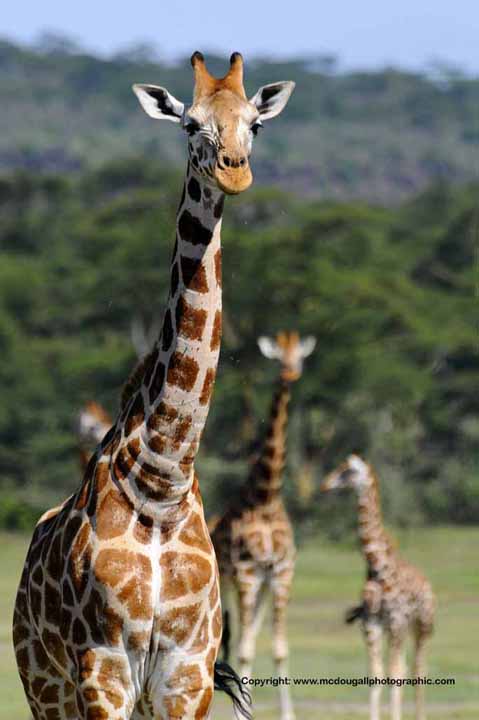
Rothschilds Giraffe
Kenya has many National Parks and Reserves, Nairobi NP is one of over 30 areas which have been set aside by the Kenyan Government to conserve what remains of the plentiful wildlife which roamed freely across the savannah of Africa. The sound of Lions can still
be heard in Nairobi NP which borders the modern capital city. It is here that many visitors have their first taste of the amazing varied wildlife Kenya has to offer.
Kenya can boast the largest and the smallest National Parks and Reserves in East Africa. Tsavo covers an area of 20,500 square km (making it larger than Israel), Saiwa Swamp is just 1.9km squared and was established especially to conserve the rare Sitatunga
Antelope. Kenya also has Masai Mara the jewel in the crown – the 7th wonder of the world where millions of Wildebeest and Zebra migrate from Serengeti in Tanzania, one of the few places where mass amounts of animals can be witnessed as in days gone by, this
is one of the most filmed and written about Natural areas in the world, a visit here in migration time will never disappoint.
A visit to Kenya can offer so many diverse and amazing habitats from the coast to Mt Kenya, from savannah to swamp, from desert to Forest there is something for everyone. It really is like nowhere on earth.
|
Burning Issues
Blue Hues of The Blue Jay
- Nita Paropkari
The Indian Roller a.k.a Neelkanth,Paalapitta and Blue Jay, is a very common bird. Ranging from the foothills of the Himalayas to Sri Lanka in the south, they are found in cultivation areas and light forest regions.
When the world was being formed by the churning of the ocean, the poison that came out first was swallowed by Shiva and he was known as Neelkanth , or blue throated as the poison turned his throat blue. The Neelkanth is regarded as the bird of Shiva and hence
its name. The bird is sacred (right!). In another tale, a very long time ago,the Kings used to release captive Indian Rollers on the eve of Dussera to signify the victory of good over evil. And yet another -When Lord Rama embarked upon his journey to kill
the evil Ravana,he spotted the Blue Jay. His victory is attributed to the sighting of the bird.
Farmers in our country hold the Roller in equal reverence because of its ability to be a superior pest controller, specially in regions of low rainfall. They walk miles to spot this bird during ten days of dussera,if they didn't see one in their own fields.
All the very same reasons make it auspicious to view the bird on Dussera day,for which poachers capture this bird weeks in advance and frequent the streets of Hyderabad and probably every other city and town to make a quick buck (as is human nature to exploit
anything and everything for money).
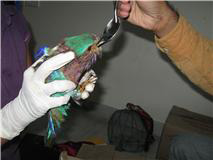
I first saw a striking flash of blue accompanied by a loud screeching..,not just blue,too many blues.There were so many different shades of blue on that bird, more blue when the wings spread,flapping relentlessly on the sides of the rusty cage. Such a huge
wing span for a tiny bird was my second thought. My focus shifted to the face of the bird..it was clearly confused, tired and in pain and still screeching, yet it looked elegant and royal. I realized it wasn't admiring me the way I was admiring it...I wanted
to yell at that man, tell him a thing or two about putting a big bird in a small cage like that, but quietly walked away and confirmed to my fellow volunteers that the man indeed had a Roller. Acting quickly,the male volunteer then held the man while I and
my friend siezed the cage from his hand and left..The poacher didn't protest or fight with us probably because he knew what he was doing is against the law.
We took the Roller to the shelter,perched it on a twig in a caged-room ,saw it drink water and left. We rescued 6 more paalapittas that day. Two of them were females,which are more of brown than blue, but were colored blue with greasy paints,so that they look
blue,Like the throat of Lord Shiva when he drank the poision. It was tough for the vet getting all that paint off them. The whole thing is tougher for the bird though.
Since then, I have volunteered to help rescue these birds every Dussera and thanks to the dedicated organisations in Hyderabad,the number of poachers bringing them to the city has depleted significantly. I dont know how many of the rescued birds survive the
trauma and how many actually die while being trapped and transported. Its wrong for people to exploit a tradition or a legend.
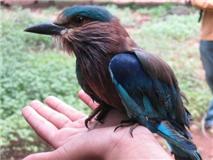
( Photograph and text by Nita Paropkari, who is with People for Animals, Hyderabad)
Comments by Prajakta Hoshangabadkar who is aggregating stories under "Green Defenders" for IndianWildlifeClub.com
Nita and her team have really done a great job. Blue jay comes in a Indian wildlife protection act schedule 3, capturing a bird for selling is punishable. Blue jay is commonly found on wire fencing of the farmers' fields. It mostly feeds on pests ,insects
in the which agricultural crops. It means blue jay is a friend of the farmer, a bird which protects their crop from harmful pests and insects. Need to stop customs and practices which are destroying beautiful as well as important creation of nature. If
we can’t create then we don’t have right to destroy too….
|
Burning Issues
Jasjyot Singh Hans is an Animation Film Design student at NID, Ahmedabad. His interests
include illustrating and reading graphic narratives. He is also environmentally aware and
concerned, like any thinking young man/woman of today is. His take on 'extinction' looming large over a large number of species, is humorous but also thought provoking.

Here is an excerpt from a report published in http://www.arkive.org
One in five vertebrate species are threatened with extinction according to a landmark study
launched by the IUCN on Wednesday 27th October 2010 at the Conference of the Parties to the Convention on Biological Diversity (CBD), in Nagoya, Japan. The timely study, which is the most comprehensive assessment of the world’s vertebrates to date, confirms
our fears that across the globe vertebrates are experiencing an extinction crisis. However, it also confirms that the situation would be a lot worse if not for conservation efforts.
" The study, which involved some 174 authors from 115 institutions and 38 countries, with
voluntary contributions from more than 3,000 scientists, is published in the international
journal Science, and used the IUCN Red List of Threatened Species to investigate the status of around 25,000 vertebrate species and how this status has changed over time. The results reveal that, on average, 50 species of mammal, bird and amphibian are pushed
closer to extinction each year. The situation has been most stark in Southeast Asia where many species are threatened by habitat loss due to the planting of crops like oil palm, deforestation by commercial timber operations, agricultural conversion to rice
paddies, and unsustainable hunting.
The study largely focused on vertebrates, but also reported that several other groups of
species assessed by the IUCN face a similar fate. The ancient group of plants known as cycads are in a particularly critical state with 63 percent of assessed species threatened with extinction, largely due to extremely high levels of illegal harvesting and
trade. Dragonflies and reef-building corals also did not fare well, with 13 and 33 percent of assessed species threatened with extinction respectively.
It is not all doom and gloom, however, as the study also reveals the positive impact of
conservation efforts for the first time, with the results suggesting that the status of
biodiversity would have declined by at least an additional 20 percent if conservation action
had not been taken. There are encouraging stories of 64 mammal, bird and amphibian species that have improved in status due to successful conservation action."
|
Corporates and Environment
Geeta Verghese, whose articles have appeared in our ezine, is spearheading a corporate social responsibility program for State Bank of india.
SBI Youth for India is looking to identify 50 of India's best minds to lead change at the grass-root level --- i.e. rural India. For more information please visit
www.youthforindia.org.

|
Endangered
Here is the first part of an article published by Shri Vinod Rishi in
Introduction
The indiscriminate hunting of tigers had greatly reduced their numbers in the country’s forests: from 40,000 at the beginning of the twentieth century, to 4,000 tigers in 1965 (Gee, 1964). The information on the population of tigers in India during the early
part of the Twentieth Century was mostly arrived at from educated impressions and not actual estimation of tiger populations. The rapid disappearance of tiger populations was noticed first by some hunters, naturalists and foresters (Thapar, 2001), and sporadic
attempts were made by some of them to check on the tiger situation in their own backyards. The Divisional Forest Officer of Palamau Division in Bihar carried out a water-hole count of tigers, the first ever systematic survey in Garu Range of his division in
1934 (Nicholson, 1934). He entertained the idea of regular checking of tiger populations, and the exercise was repeated in Palamau in 1936 and 1938 (Chaudhuri, 1938). It marked the beginning of the monitoring of tiger populations in India.
Over the next 75 years, 1934 to 2010, the monitoring of tiger populations progressed through three distinct phases of development. The first phase covered the years from 1934 to 1971, and during this phase different field methodologies for counting tigers were
tried out in some tiger habitats. In 1940s, the Maharaja of Bundi in Rajasthan estimated tiger population in his area (Sankhala, 1969, 1978). Since 1953, monitoring of tiger populations became an annual feature in Kanha. Schaller, during his research study
from 1962 to 1964 in a small part of the Park, estimated a tiger population between 10 to 15 in his study area (Schaller, 1967). He identified 11 adult tigers from their facial markings (Panwar, 1979b). S.R. Choudhury experimented with tiger census in Orissa
in 1966, and subsequently at other places to develop a methodology that came to be known as Co-operation Tiger Census and was later used by Project Tiger. Mishra applied Stratified Sampling approached to his Winter Track Counts in Palamau for four years (Mishra,
1970, 1971, 1972, 1973); Uttar Pradesh recorded 481 tigers in 1969 (Singh, 1969).
The next phase, from 1972 to 2004, systematized integrated State and National level monitoring of tiger populations. The first all India tiger census took place in 1972 using ‘Co-operation Tiger Census’ methodology, and the methodology for numerical estimation
of tiger populations was employed by Project Tiger from 1973 to early 1980s (Choudhury, 1970a, 1970b, 1971, 1972a, 1972b, 1979); ‘Pugmark Census Technique’ (Panwar, 1979a), a highly simplified deviant of Co-operation Tiger Census replaced ‘Co-operation Tiger
Census’ in mid 1980s and remained in use by Project Tiger till 2004. The validity of field census techniques was challenged in late 1980s, and new statistical estimation approach using Camera-Trap and Capture-Mark-Recapture model was suggested for monitoring
tiger populations (Karanth, 1987, 1988, 1995, 1999, 2003; Karanth et al. 2000, 2002). Refinements in field methodologies were suggested by some (Rishi, 1997, Singh, 1999); analysis of pugmarks using computer software was introduced in West Bengal (Roy, Undated).
A group of specialists recommended a judicious mix of both the modified field methods and statistical approaches for use in monitoring tiger populations (Singh, et al, 1997).
The third phase in the development of monitoring techniques started in 2005, with the application of a ‘Holistic Approach’ for monitoring tigers, co-predators and prey species and their habitats, by the newly constituted National Tiger Conservation Authority
(NTCA). Numerical census of tigers was replaced by Systems Analysis approach using a heirarchical model and statistical estimation techniques for determining the status of tiger populations (Jhala et al. 2005a, 2005b). In 2008, the all India Report on the
Status of Tiger, Co-predators and Prey Species was published by the NTCA (Jhala, et al, 2008). The NTCA reported their estimate of the tiger population in India to be between 1,167 and 1,657.
There are other methods using different indices, such as the Pugmark (Digital Image) Analysis technique (Sharma et al, 2001), and the estimation of tiger populations using DNA profiles (Goyal, et al., 2007) being developed for monitoring tiger populations
in India.
-to be continued
|
Events
Wildlife Photo exhibition in Nagpur
Parag Deshmukh invtes all to participate in a photo exhibition:
Srushti Paryavaran Mandal, an NGO from Nagpur is conducting a wildlife Photo exhibition cum competition on the first death anniversary of Raju Harkare, who was an avid wild lifer, an excellent birder and a photographer.
We are looking for photographs on wildlife, or landscape, or a picture of a rare species. for more info please visit
http://srushti.org.in/acitvities/photoexhibition.html
Last date to submit photos is 15th Dec 2010
Renowned photographer Baiju Patil will be the judge and Mr.Fateh Singh Rathod will distribute the cash prizes and also will show a presentation of his work on tigers on the concluding day i.e 26th at Ravindranath Tagore Art Gallery, Ambazari, Nagpur. Event
will be held on 25th and 26th Dec.2010
for more info you can call on 9922429040, 9370182568
or email paragdeshmukh@yahoo.com
Amoghavarsha JS invites you to
Landscape photography workshop
Friday, December 17 at 9:00pm - December 20 at 7:00am
Location Sharavati valley
Add color to your landscape photography skills. Hone your passion for nature and landscape photography in a classroom set in the middle of the Western Ghats in the Sharavati Valley. Get to photograph some of the most mind-blowing landscapes in ever witnessed.
Spend time in one of the most pristine bio-diverse areas of India. Photograph India's tallest waterfall at Jog, the beautiful valley of Sharavati, the Prehistoric rock formations of Yana and breathtaking backwaters of Linganamakki. This workshop aims at perfecting
landscape shots, with a focus on conserving fragile ecosystems. Not only do you learn how to get the WOW shots, but you also spend time in places that provide most unique and breathtaking photographic opportunities.
More details at
http://amoghavarsha.com/workshops/sharavati/
Pritesh Nandvikar invites you to a
Nature trek to Rajmachi (Lonavala)
Monday, December 27 at 2:30pm - December 29 at 5:30pm
Location Rajmachi (Lonavala)
Dear friends,
Wild explorers (WE) formerly known as WRRACC (Wildlife Research Rescue & Conservation Club) is a nature club, registered under WWF (World Wide Fund) which work for conservation of wildlife and nature. The main emphasis is given to the rescue & rehabilitation
of the wild animals. Now WRRACC is serving since almost 5 years after an establishment in the year 2005. Today the club has more than 10 confirm committee membe...rs & several members through online club subscription. Although the main activity is wild life
rescue & rehabilitation especially snakes, the club also conducts various activities related to wildlife and nature conservation & adventure.
WE is organizing 3days 2 night nature trek to Rajmachi (Lonavala).
Rajmachi (Udhewadi) is a small village in the rugged mountains of Sahyadri in India. There are two forts which were built by Shivaji Emperor during 17th century. It is a famous spot for trekking. It is about 15 km treking distance from Lonavla. Rajmachi fort
is a strategic fort overlooking Borghat(ghat between Mumbai and Pune) which was a historical trade route. Rajmachi peak has two fortified structures - the Shrivardhan fort and Manaranjan fort. Rajmachi can be reached by 2 ways, the tough route from Kondivade
village near Karjat and the other easy but long way route from Lonavala. In rainy season this place is filled with giant waterfalls and greenery.
The details are as follows:
Type of trek: Medium
Cost: 800/- per head
Cost includes:
Travelling to & fro by bus (ST)
Food during the outing. (Except 1st meal)
Morning/ Evening tea/coffee with breakfast.
Afternoon/ Night simple vegetarian meal.
Activities:
Nature information during the outing.
Snake information session.
Nature games.
Night trail.
Nature & wildlife photography session.
Jungle surviving techniques. & many more….
Things to carry:
Shoes (additional small foot wear), Rainwear (optional), cap, glassware, mosquito/ insect repellents, personal medicines.
Don’t carry handbags, sacs are recommended.
*Please inform the coordinators prior about specific health problems or any allergic reactions.
Please don’t leave any plastic or papers behind which can harm the nature.
Don’t carry any valuables during the trek.
Follow the instructions given by the coordinators during the trek.
Authority will not be responsible for loss of any valuables viz. Camera, mobile. Walk man, ornaments etc.
Participants should report on time.
for registration & further details kindly contact
pritesh 9820317199
saurabh 9821958362
Enchanted India invites you
December 3 at 8:00pm
Location Gir and Little Rann of Kutch
We - Nik (Nikhil Devasar) and Dicky (Aditya Singh)- have been into wildlife travel in India for over 15 years. Both of us are accomplished naturalists, photographers and wildlife enthusiasts. If we take you somewhere you can be assured that we have been there
and done that many times over. The only lodges and camps that we use are those that we are very closely associated with. This is why we have the confidence of offering you the best possible rates and services. We have all the ingredients to blow your mind
and we put them together to create the perfect recipe for an unforgettable wildlife adventure. Best of all, we do it without making a dent in your pocket.
28th Nov, Sunday: Our tour starts as we arrive into Ahmedabad and are transferred to the waiting cars and drive to Gir Lion sanctuary. We arrive at the lodge by Lunch. After lunch we set out for an afternoon of birding around the lodge which is set amidst a
mango orchard. Apart from Birds and the famous Asiatic Lions, Gir also has one of the largest leopard populations in any park in India, making it a good place to spot different big Cats. Overnight stay at Lodge. Meals Lunch and Dinner.
29th Nov, Monday: We spend our day with morning and afternoon game drives in the park with naturalists. Other wildlife to look out in Gir are the four horned antelope, Indian gazelle, spotted deer, blue bull, wild boar, wolf, Hyena, Jackal, Jungle cat, and
other small mammals.
The Kamleshwar dam in the middle of the park is also home to a record number of marsh crocodiles. Return for Dinner and overnight stay at the lodge. Meals Breakfast, Lunch and Dinner.
30th Nov, Tuesday: Explore more of the Gir national park with another round of morning and afternoon safari for Lion tracking. Look out for other mammals and birds that are part of this park and landscape. Overnight stay at Lodge. Meals Breakfast, Lunch and
Dinner.
1st December, Wednesday: We leave early with packed breakfast for the Little Rann of Kutchh. Far from being ‘little’, the Little Rann of Kutch boasts of being one of the largest wildlife sanctuaries in India. It sprawls over some 4950 sq km and is an abode
of saline desert plains, arid grasslands, rocky and thorn scrubs, lakes, swamps and not to forget the diverse wildlife species. After lunch we venture out for an afternoon safari in the Rann to get a taste of the vastness and diversity of the place. Overnight
at Lodge. Meals Breakfast, Lunch and Dinner.
2nd December, Thursday:
We leave at day break with packed breakfast for our morning safari. With the unique landscape, the Rann provides for us with an unending possibility of exploration. Apart from being home to the highly endangered Wild Ass, Little Rann is a resting site for migratory
birds and breeding grounds for some of the largest flocks of Greater and lesser Flamingoes. The Rann is also the roosting site for thousands of Cranes. Return to the Lodge for lunch. After Lunch we again head out for the Rann. We return as the cranes are coming
in to roost. Relax and unwind and overnight stay at the Lodge. Meals Breakfast, Lunch and Dinner.
3rd December, Friday: We spend our last morning again with a safari in the Rann admiring and taking in this unique piece of landscape which boasts of such a wide range of wildlife. After the safari we head back to the Lodge to shower and pack. We then head
back to Ahmedabad for our onward journey by rail/ flight. Meals Breakfast
Cost of Tour: Rs 24,400/- on Double sharing
Includes:
All stay and meals as mentioned
All entrances and safaris
Does not include:
Tips
Mineral Water
Flying Kingfishers or any other booze
Contact details:
Indian Adventures Eco Tours Pvt Ltd.
F-313, Lado Sarai, New Delhi - 110030.
Telephone: 011 44128785
Nik: 09810008625 – nik@asianadventures.in
Dicky: 09414030221 - dickysingh@gmail.com
|
Events
Nature Education Program
2nd Workshop on Herpetology and Captive Maintanence of Reptiles
Dipak Mitra invites you
Time
Friday, November 19 at 9:30am - November 21 at 5:00pm
Location Calcutta Snake Park
Hello Friends!
This November, Reptile Instinct, an initiative by Calcutta Snake Park is coming out with a unique program that will give its participants an opportunity for hands on experience into the ever declining natural world. Posted below is the brief.
REPTILE INSTINCT
Reptiles are widely misunderstood. They hardly ever get justice for their actions. Hence it is only through awareness that people will learn to respect nature and its components. Reptile Instinct, an initiative by Calcutta Snake Park, focuses on building a
network of people, who single-mindedly work towards creating a platform for conservation of wildlife, world over. This requires young people to experience the work, trials, successes and efforts that are being made at the grass root level. Pursuing this vision,
the initiative engages Volunteers, from the world over and of different aspirations, to contribute and grow together with the facilities and efforts. The works assigned to the volunteers are planned and extensive. This includes research and conservation studies
that will have to be completed during the stay, immense skill dependent work that contributes towards the growth and success of the particular initiative. In return, this will generate more revenue which may increase the work force for the various activities
and efforts and enhance the ongoing research work.
Workshop focusing on the following topics:
1. Reptile Ecology
2. Field herping Techniques
3. Survey Methodology
4. Captive Husbandry and management of reptiles
5. Snake bite first aid.
6. Plenty hands-on experience !!
Total duration of workshop: 19th November to 21st November 2010
Assembling at: Calcutta Snake Park at 10am
How to reach: Please see website: http://www.dipakmitra.net/
Who can attend?
The workshop is skill and knowledge oriented. Anyone can participate. Age, sex, occupation no bar.
Accommodation: Separate Ladies and gents dormitories available.
(For more information and to register, please write to Suvrajyoti Chatterjee in reptileinstinct@gmail.com or call Dipak Mitra on +91 (0) 9674278568)
7 DAYS PHOTOGRAPHY WORKSHOP
Vishwajeet Naik invites you
Time
Sunday, November 28 at 6:00pm - December 5 at 5:00am
Location HOUSE OF ART
9'SATVELY ROAD CAMP, Pune
The details of the workshop are as below:
• Understanding Camera fundamentals (Aperture, Shutter speed and ISO)
• Using Your Camera's Automatic Settings for Eye-Catching Outcomes
• Photography Lighting and understanding effects of lighting
• Basic Photography Composition
• Still/product photography session
• Portrait photography session
• Fashion photography session
• Architectural Photography session
• Sports and wildlife photography session
• Night photography sessions including light painting
• Black and White Photography
• Learning Basics of Image editing (PHOTOSHOP)
• Analyzing students work
Butterfly Fest at Vasai Fort on November, 27,2010.
Nikhil Disoria invites you
Time
Saturday, November 27 · 6:00am - 12:30pm
Location Vasai Fort, Mumbai
Hi all,
SPROUTS is Organising a Butterfly Fest at Vasai fort.
You all must have heard of the Vasai Fort, a construction standing for
over 400 years, just outside Mumbai. Since, much of the original fort
building has been damaged and a dense forest has grown inside the huge
...fortress (originally build to encompass the seven fishing villages in
and around Vasai), the place is a good habitat for many birds, frogs,
butterflies and other small creatures. The fort provides shelter for a number of species of birds which were once common in the Mumbai city, but have been displaced due to the growing population and pollution.
Also found in the fort is a huge diversity of butterflies. A famous spot
where over 100s of striped tiger, crow, pansy and other butterflies roost during winter. But butterflies are juts one of the highlights of the place. You can get to see some interesting flora too in the fort!
The outing fees are Rs.100 + transport for members and Rs. 125 + transport for non-members.
Please confirm your participation latest by November 22,2010. Please note, it is mandatory to register and pay advance to attend the outing, so that suitable resources can be arranged.
Everyone is requested to carry some snacks and a water bottle. Please wear camouflaging clothes red ,yellow and other bright colours are not advised. Wearing perfumes,jewellery or other expensive things like ipod should be avoided. Also cap and sunglasses are
advised.
Payments for Bookings to be done in full cash advance at SPROUTS Earth Shop, 5, Pawar Shops, Rani Sati Marg, Malad (East), Mumbai 400097, Tel: 28784889. You can also do an online cash transfer to Anand Pendharkar 000-401-535-219 - ICICI Bank Nariman Point Branch
and send an email to sproutsonline@gmail.com with names, age, gender & place of origin.
Schedule:
Meet at the Vasai Road Railway Station Ticket Counter (West) at 7.30
am on November 27,2010.
The trail will continue till 12 noon.
Beach Walk at Navagaon on November, 20,2010.
Nikhil Disoria invites you
Time
Saturday, November 20 · 6:30am - 12:00pm
Location Navagaon beach, near Arnala (Virar), Mumbai
Dear Friends,
SPROUTS is organising a Beach-Walk at Navagaon beach, near Arnala (Virar). The Navagaon beach is being monitored by volunteers of the Sahyadri Nisarg Mitra (SNM) Group and they have found it to be one of the few turtle nesting sites in North-Western Maharashtra.
The beach is fairly unpolluted and has a large floral and faunal diversity - some probably yet to be identified! In continuation of our last few year's Beach Walks, SPROUTS takes the opportunity to explore the marine
life of the beach and also our favourite avifauna.
Event Date: November 20, 2010.
Timings: 7:30am-12:00noon
Meeting Point: Virar S.T Depot (West) at 7:00am
Outing Fees: 150/- (including light tea & snacks, Study Material,
Expert Guidance) *The above cost will not include Mineral water, Other
Beverages, to and from Transport etc.
Last Date for confirmation: November 15, 2010.
Please carry sufficient water (2lts), food (fruits, sandwiches, thepla),
headgear (cap/hat), closed shoes, rainwear/umbrellas...
Hope to see all of you and maybe we can also enjoy the early winter migrations!
Payments for Bookings to be done in full cash advance at SPROUTS Earth Shop, 5, Pawar Shops, Rani Sati Marg, Malad (East), Mumbai 400097, Tel: 28784889.
You can also do an online cash transfer to Anand Pendharkar 000-401-535-219 - ICICI Bank Nariman Point Branch and send an email to sproutsonline@gmail.com with names, age, gender & place of origin.
Island Ecology Workshop
Gerard Martin invites you
Time
Monday, November 22 at 7:00am - November 27 at 12:00pm
Location Andamans
Andaman and Nicobar Islands!
The Andaman Islands are an almost fabled archipelago with clichéd sun-kissed beaches, blue waters and incredible coral reefs. However, there is a lot more that is spectacular on these islands! There are mangrove forests, intertidal zones and rainforests as
well and all these habitats are dependent on each other, as are the flora and fauna that live within them.
We will explore four separate habitats, ...better understanding the dynamics at play within them and how they affect each other. Along the way, we will build skills in surveying techniques, canopy access, snorkeling and scuba diving.
We’ll be staying at the premier conservation and research body on the islands- The Andaman and Nicobar Environmental Team’s field station and get involved with their experiences, work and endeavors. The field station is located with mangrove forests and inter-tidal
zones adjoining it and the five-acre campus is a well-preserved rainforest!
The workshop will encompass a lot of learning skills, experiencing new ecosystems and getting numerous photo opportunities. We’ll see many species that are unique to the islands and some that are adapted specifically to life in island habitats.
One day will be dedicated to snorkeling and another will be spent scuba diving to better experience the coral reefs and also build skills.
ACTIVITIES:
Understanding Island Ecologies
Mangrove walks- Searching for specialized animals
Intertidal Zone- Understanding this unique niche
Visits to the reef
Looking for crocodiles
Herpetofaunal surveys
Photography sessions
Ecology presentations
Canopy access
Snorkeling for marine life
Scuba Diving
Loads of hands on experience
Night surveys
Andaman and Nicobar Islands Environmental Team (ANET)
The Andaman and Nicobar islands are a chain of some 300 little known archipelagic islands situated on the eastern rim of the Bay of Bengal. Closely guarded by the Indian Government, they remain a pristine tropical island paradise, complete with stunning coral
reefs, crystal blue waters and unspoiled equatorial rainforest. Most extraordinary, many of the islands are a bastion for some of the last remaining aboriginal tribes on earth that continue to shun all contact with the outside world. The Andamanese, as these
tribes are collectively known as, inhabit a significant percentage of the islands in fully protected areas that remain completely off limits to the general public.
Shortly after setting up the Croc Bank in the 1970s, the Whitakers realize there were needs for basic herpetological and other ecological work in the then much neglected islands. Over the next several years Rom, together with Satish Bhaskar and Alok Mallick,
set about crafting a strategy to effectively address these issues. The Andaman and Nicobar Environmental Team (ANET) was conceived in 1989 and shortly thereafter five acres of land was purchase and a base station constructed in Wandoor, on the southern tip
of South Andaman island.
ANET has since carried out extensive work on marine turtles, herpetofaunal biogeography and a host of other biological studies. In addition, ANET has been actively involved in the broader ecological and social spheres including work on natural resource utilization,
socioeconomics and the management of protected areas.
As one of the most capable NGOs in the region, ANET played a pivotal humanitarian and disaster relief role in the Nicobar Islands after the infamous 2004 tsunami devastated the region. Today, although still very active in the reptile arena (with a recently
described genus of Agamid named at the base to prove it!) ANET has a very broad curriculum of environmental development work, including marine and terrestrial components. ANET is the only environmental research base in the islands and remains one of the Croc
Banks most exotic and luxurious projects – our very own Treasure Island!
Program Dates- 22nd to 27th November, 2010.
For further details or to register please get in touch with Conan on 9449010673 (conan@gerrymartin.in)
Rainforest Ecology Workshop
Chetana Purushotham invites you
Time
Friday, December 3 at 8:00am - December 5 at 7:30pm
Location Agumbe Rainforest Research Station, Karnataka
Cobras, Canals and Carabineers
A Rainforest Ecology Experience
Unfairly called the Cherrapunji of the South, Agumbe possesses a lot of its own unique charm and enigmas. Known primarily for the almost unfathomable rain and the clichéd and touristy ‘Sunset Point’, this sleepy town of Malgudi Days fame remains a tiny dot
on the highway between Shimoga and Mangalore.
Geographically, the area is a small and low basket in the Western Ghats and consists of very unique flora and fauna. One of the few lowland evergreen forests in the Western Ghats, Agumbe is a naturalist’s dream, offering excitement and discovery at every corner.
This December, Gerry Martin will be taking a group of enthusiasts over to the Agumbe Rainforest Research Station to provide them with a learning experience by getting involved with the various projects that the Research Station is conducting. There will also
be skill-building sessions where individuals can learn various techniques in wildlife field biology.
Activities:
Stream Exploration
Radio Tracking
Canopy Access
Survey Techniques
Night Surveys
Camping Out
Waterfall Hike
Plenty of Photo Ops
Various learning presentations
Topics will include:
Reptile taxonomy, rainforest ecosystems, snakebite first aid, radio telemetry, king cobra breeding biology, etc.
Who can attend this workshop?
Anyone who is 12 years and above and interested in Nature can attend this workshop. It is open to children and adults. The age range on our workshops has been as large as between 12 and 60 years old! All levels of dialogue, interest and skills are addressed
and accommodated.
Accommodation and Logistics:
The group will travel via overnight bus to Agumbe on the 2nd of December. The bus departs from the Majestic Bus Stand in Bangalore at 10 PM. We will be staying in tents at the field station. There is a common dining area and the bathrooms and toilets are permanent
structures with hot and cold running water.
We will return early in the morning (usually around 5 AM) on the 6th of December.
For further details or to register, please get in touch with Conan Dumenil. 9449010673/ conan@gerrymartin.in.
|
Gardening for wildlife
(Contd from last month)
The Butterfly Diaries
Fortunately, I have never found, horror of horrors, the arch-villain, in my shoes or garden - the saw-scaled viper. I'm sure he must be there for my garden is fenced with old duck-boards standing upright, but I never saw him. Nearby yes, but never in my garden.
But lets put these night-time experiences away, for the sun has peeped over the dunes. At this time, strangely, it is not the birds that draw you but the bees. For my garden boasted two hives of bees. They appeared almost together one year after the winter
had passed. The largest was in the tree and belonged to Apis florea, Dwarf Honey Bee. The second hive in the thatch of my garden fence behind a bamboo 'patti' screen was the hive of Apis cerana, the Asiatic honeybee. For a brief period these hives flourished,
each oblivious of the other, and just as suddenly died out in the autumn. But while they were there, the humming of bees around the sunlit portulacas gave an almost-ethereal feeling to me drowsing in my plastic garden-chair under the tree.
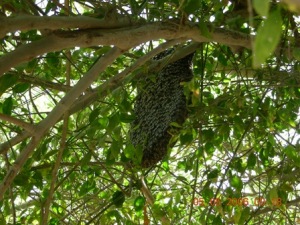
The hive in the tree! (Apis florea)

The hive in the thatch. (Apis cerana)
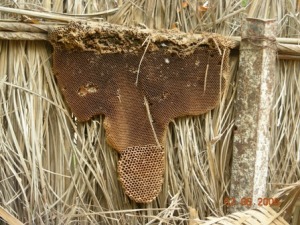
The abandoned thatch hive exposed. Never imagined it to be so large!
The authorities pipe water twice a day, once in the early morning and once after dark. So in between these times, you are dependent on water in the roof tanks and stored water in the bathroom buckets. Water is life in the deserts. The pipeline supplying the
garden has a small leak at the place where it bends around the garden corner and there it leaks. Each morning, the garden creatures are treated for an hour or so to a thin lamellar flow across a patch of cemented pavement. I have forbidden its repair so that
the creatures can get their small but just desserts!
The bees buzz here across the garden from the hive , and like teenagers wearing many pocketed jeans, they pick up water in the small cups or satchels on their legs and take off for the hive. I imagine this water is used to keep the queen and the larvae air-conditioned
through the summer. The bees drink greedily of this water and long after it has stopped they crowd the fence, pipe, wet gravel and moist soil with an unquenchable appetite.
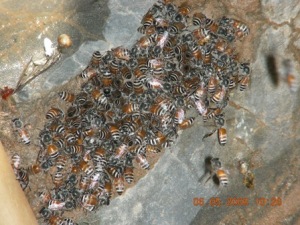
Its not just humans who store water each day!
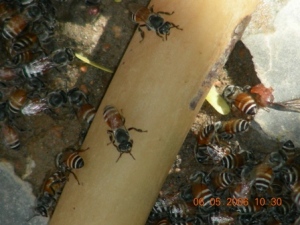
The bees crawl everywhere to get at the water. (Apis cerana)
Seeing this and the fact that their presence kept some small creatures away I added two more sources of water. A pot of water hung from a tree branch for the birds and bees and a earthen water-bowl for the squirrels, jirds and other creatures at ground level.
Since I was watering them, I decided to feed them, so I added a small wooden feeding tray. The carpenter was so gratified at being asked to do so noble a task that of his own he added a bird-house to the tray. I did'nt have the heart to put him right but gave
him an extra shabash! Anyway, the bees now started raiding the water-pot in the mid-morning and afternoons too!
-(To be continued)
|
Gardening for wildlife
The Butterfly Diaries
It was a childhood wish of mine to have a secret garden all to myself. I did realise the dream when I was much older and the garden I had then was not quite secret. Despite this, it contained a secret world which was invisible to all who passed through or
passed by but was always available to me whenever I wanted to place the cares of office behind and was ever a source of delight and fascination.

As gardens go, it was a slip of one, hardly 20 yards by 25 yards, just large enough to form the facade of the small two-roomed bungalow in the desert of Jaisalmer where I lived. Indeed it had only a single tree, a patch of grass, some creepers on the fence
and a few potted plants but it was peopled by creatures who gave me small glimpses of their lives.
My day begins early, the "ploonk plink" of bulbuls and the "caw caw caw" of the crows is infinitely preferable to waking up with the help of an alarm clock. It is just after dawn, the sky is still grey as the sun has not risen over the dunes at the horizon
and the breeze which blows across the sand is still cold. The last vestiges of night-life can occasionally still be seen. Today, a flicker of movement at the corner of my eye causes me to turn my head, just in time to catch a last glimpse of the tail of the
large desert monitor (Varanus griseus) who lives behind my bungalow in a hole amidst a tangle of barbed wire. He has a regular nocturnal beat at this time of the year which takes him through the matchbox-sized gardens of the three bungalows side-by-side, then
around the large store-house, into the transport yard, across the bordering dune, and back along it on the far side till he rounds the dune, crosses a road and is back into the tiny gardens.
Sometimes, late at night I find a large, prickly and wicked looking arthropod, the solifuge, who patrols my garden each night for insects and small life. Of him, I have written elsewhere.
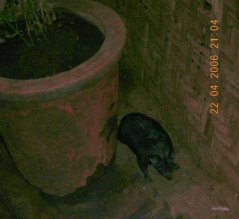
The hedgehog creeps by at night
About him and the Varanus, the hedgehog does not know or care, for about once a fortnight, he pays me a visit.
It is always dark when he comes for a sip of water from the squirrel-bowl. He easily finds his way in but for some reason stumbles on his way out and so I notice him. He scrambles between the bowl and fence but there is no exit there. He tries the jird's hole
but I lift him and place him on the road outside my bungalow free to go where he wills.
He is easily trapped, and since taking a good picture is difficult, so one day, I catch him and keep him till day-time when I photograph him.
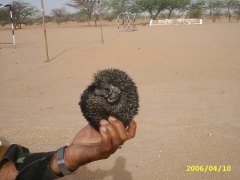
Hedgehog held in hand peeps out
Hedgehogs are difficult to identify and my guides are not quite comprehensive and the descriptions not specific enough, so, like a lot of amateur naturalists, I call it an Indian Hedgehog and leave it at that.
Night too leaves behind a few small villains, who now appear or can be found where they were not present the previous evening. I am referring, of course, to the scorpions who have the knack of turning up where you never expected to find it - on the outside
of the 'macchar-dani' (mosquito net), in the folds of the towel on the rack, three feet above the ground or in your boots, the one day you forget to check. Then, its a ''EEYOWW' followed by the immediate,abrupt and merciless extinction of the perpetrator and
later on a local anaesthetic and some salve. A few bites later, you realise it was the fright and unexpectedness which raced your heart more than the pain and it was your ego that required the balm more than the sting.
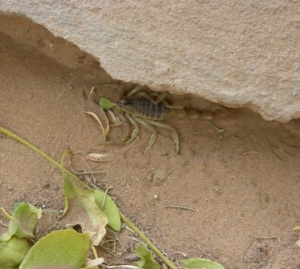
"Curses"discovered again!
|
Green Defenders
Green Defenders at - Madhya Pradesh
reported by-Prajakta Hushangabadkar (People for Animals)
Madhya Pradesh is the heart of the India. Kanha, Pench, Bandhavgarh etc. are famous tiger
reserve bases in this state.
Last week I visited Bhopal’s well-known Janhagirabad market known for butcher shops and pets shops. It is located near police residential quarters in Bhopal. I found the shopkeeper deal with customers for parakeets, pigeons, ducks, tortoise-turtle and many
exotic birds too. Even many animals like rabbit, cats etc. were stocked in the shop. There were 40-50 parakeets (gray headed, blossom headed, Rose ring and Alexandra parakeets) for sale.
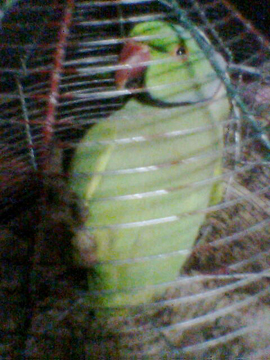
When I tried to question the people they said it was regular business here. I tried to lodge a complaint against the dealers. But the forest department were or not aware that these parakeets come under Indian wildlife protection act. (Parakeets come in schedule
4). Initially they tried to dominate me, but later relented by giving me a flying squad. We could only rescue parakeets since the department was least interested. The department stated that dealers possessed weapons and chances of charging against officers
after raid was possible. That is why we could only rescue parakeets.

Though birds are used as a source of entertainment it may be noted that they play an integral role in the ecological system. They help in restoration of forest by dispersing seeds of the various fruits they consume. There arises a need to create awareness
regarding their role in environment as well as the legal laws related to their protection. I wish I would do the rescue again at jahagirabad market at Bhopal.
Please try and stop illegal trading of birds by creating awareness about the problem and with help of the legal laws for protection of birds.
|
News and Views
eGov2.0 Award for Best Social Media Initiative
India eGov 2.0 Awards 2010 conferred an award for best social media usage to the initiatives of Indian WildlifeClub.com.
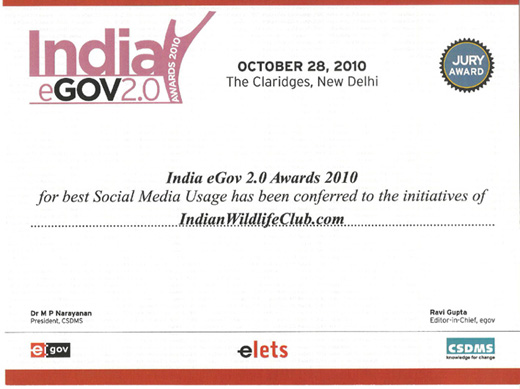
Elets Announces India eGov 2.0 Awards for year 2010
New Delhi, October 28, 2010: Elets Technomedia today announced the India eGov 2.0 Awards 2010 for the most innovative usage of Social Media and Web 2.0 tools for governance and social development in India. It also announced the best website awards for online
initiatives by the government and public sector organisations.
Instituted by eGov magazine, the India eGov 2.0 Awards aims to felicitate and acknowledge
unique and innovative initiatives in the use of social media tools for creating interactive
platforms for improving citizen service delivery or for sharing and garnering information to
meet the larger social development goals by the government and private sector bodies
including citizens, citizen groups, NGOs and political parties.
Giving details of the awards Elets Technomedia CEO Dr Ravi Gupta said, “India eGov 2.0
Awards is a unique initiative that will help bring to forth best practices of government and
public sector websites and use of social media tools by them, as well as by civil societies
and various development organisations in the country.”
The Grand Jury was chaired by Mr. Ashish Sanyal, Sr Director, Department of IT, Ministry of
Communication & IT, Government of India. The members of the Grand Jury included Ms. Neeta Verma, Sr Technical Director, NIC & Coordinator for National Web Ratna Awards; Ms. Krithiga Reddy, Director of Online operations, Facebook India; Mr. Kamlakar Kaul, Chief
Strategy Officer, Government Business, EMC; Mr. Niraj Prakash, Director—Public Sector Marketing, Microsoft Corporation (India); Mr. Sandeep Raina, Sr VP, North, Cisco India & SAARC; Mr. Sunil Kapoor, Zonal Director, Fortis Healthcare; and Mr. Mrutyunjay Misra,
Director, JuxtConsult.
Social Media Usage (JURY AWARD)
1. CGnet Swara
2. IndianWildlifeClub.com
3. Praja.in
Criteria for evaluating most innovative social media initiative for governance and social
development:
1. Objective
2. Innovation in use
3. Impact and outcome
4. Community connect (reach)
5. Services offered
6. Interactivity or responsiveness
( excerpts from http://www.egovonline.net)

The award was received by Dr.Susan Sharma, founder, IndianWildlifeClub.com. Dr.Ajay Kumar, Chairman KSITM & Pricipal Secretary, Department of IT , Kerala gave the award. Panel Chairman Shailesh Gandhi, Information commissioner, Central Information Commission
and Dr.Ravi Gupta, CEO of egovonline.net look on.
Watch a video clip on the jury meetings held for India eGov 2.0 Award
http://www.youtube.com/watch?v=JnVEEpbRTFU
|
Web Page
-Dr Susan Sharma
Explore our newest feature-My (personalized learning) Page!
Over the years IndianWildlifeClub.com has developed into a Community of Practice with users sharing experiences through online chats, travel experiences, web blogs and original articles.
We have channeled this information into knowledge, in a Personalized Learning Environment
(PLE) on the web portal. Environmental sustainability will be everyone's concern, if each
one of us discovers his or her own personal reason to be concerned about it.
All registered users can now change their profile details, see their uploads (blogs, trip
reports) on the portal, see the searches they have made in one place and also scribble notes and save them.
Indianwildlifeclub.com is inspired by and moulded by the vision of E.Wenger’s Community of
Practice concept.
"Communities of practice are groups of people who share a passion for something that they
know how to do, and who interact regularly in order to learn how to do it better.
"A community of practice is not just a personal network: it is about something. Its identity
is defined not just by a task, as it would be for a team, but by an "area" of knowledge that
needs to be explored and developed.
"A community of practice is not just a Web site or a library; it involves people who
interact and who develop relationships that enable them to address problems and share
knowledge. Over time, they accumulate practical knowledge in their domain, which makes a
difference to their ability to act individually and collectively. Domain provides a common focus; community builds relationships that enable collective learning; and practice anchors
the learning in what people do." Wenger E, (2001 and 2004).
Environment Education for students-Personalised Learning Environment (PLE)
We hope that "My Page" will augment the learning of students who are interested in
environment, conservation and ecology.
A definition given by Lubensky R, (2006) points a “PLE as a facility for an individual to
access, aggregate, configure and manipulate digital artifacts of their ongoing learning
experiences.”
The primary function of universities is to equip students with the knowledge and skills they
need to prosper throughout their professional career. Today, to be successful, students will
need to continually enhance their knowledge and skills, in order to address immediate
problems and to participate in a process of continuing vocational and professional
development.
Involving students in managing their own learning in a variety of contexts, such as building
their own personal learning environments (PLEs) according to their goals and interests, is
one way of developing the skills and motivation that will serve as tools for lifelong
learning beyond their formal education.
With the urgency and immediacy of many environmental issues, all of us are students in a life-long learning process. Let us help each other by communicating, sharing and acting.
We look forward to your feedback on "My Page". To get your very own "My Page", register on http://www.IndianwildlifeClub.com by going to the top right hand corner and clicking on "Register Here"
|